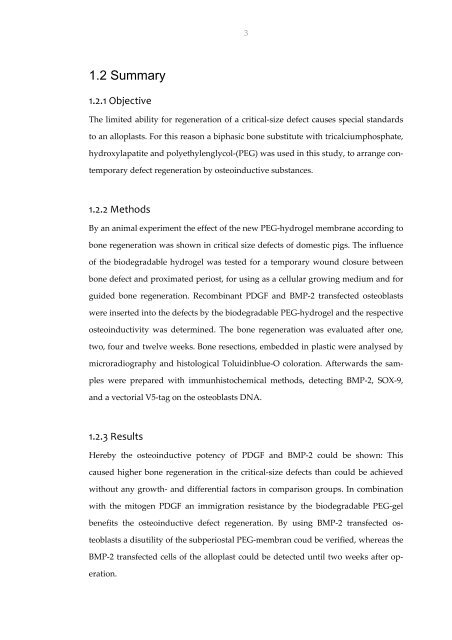Ossäre Regeneration eines experimentellen critical-size Defektes ...
Ossäre Regeneration eines experimentellen critical-size Defektes ...
Ossäre Regeneration eines experimentellen critical-size Defektes ...
Sie wollen auch ein ePaper? Erhöhen Sie die Reichweite Ihrer Titel.
YUMPU macht aus Druck-PDFs automatisch weboptimierte ePaper, die Google liebt.
1.2 Summary<br />
1.2.1 Objective<br />
3<br />
The limited ability for regeneration of a <strong>critical</strong>‐<strong>size</strong> defect causes special standards<br />
to an alloplasts. For this reason a biphasic bone substitute with tricalciumphosphate,<br />
hydroxylapatite and polyethylenglycol‐(PEG) was used in this study, to arrange con‐<br />
temporary defect regeneration by osteoinductive substances.<br />
1.2.2 Methods<br />
By an animal experiment the effect of the new PEG‐hydrogel membrane according to<br />
bone regeneration was shown in <strong>critical</strong> <strong>size</strong> defects of domestic pigs. The influence<br />
of the biodegradable hydrogel was tested for a temporary wound closure between<br />
bone defect and proximated periost, for using as a cellular growing medium and for<br />
guided bone regeneration. Recombinant PDGF and BMP‐2 transfected osteoblasts<br />
were inserted into the defects by the biodegradable PEG‐hydrogel and the respective<br />
osteoinductivity was determined. The bone regeneration was evaluated after one,<br />
two, four and twelve weeks. Bone resections, embedded in plastic were analysed by<br />
microradiography and histological Toluidinblue‐O coloration. Afterwards the sam‐<br />
ples were prepared with immunhistochemical methods, detecting BMP‐2, SOX‐9,<br />
and a vectorial V5‐tag on the osteoblasts DNA.<br />
1.2.3 Results<br />
Hereby the osteoinductive potency of PDGF and BMP‐2 could be shown: This<br />
caused higher bone regeneration in the <strong>critical</strong>‐<strong>size</strong> defects than could be achieved<br />
without any growth‐ and differential factors in comparison groups. In combination<br />
with the mitogen PDGF an immigration resistance by the biodegradable PEG‐gel<br />
benefits the osteoinductive defect regeneration. By using BMP‐2 transfected os‐<br />
teoblasts a disutility of the subperiostal PEG‐membran coud be verified, whereas the<br />
BMP‐2 transfected cells of the alloplast could be detected until two weeks after op‐<br />
eration.

















